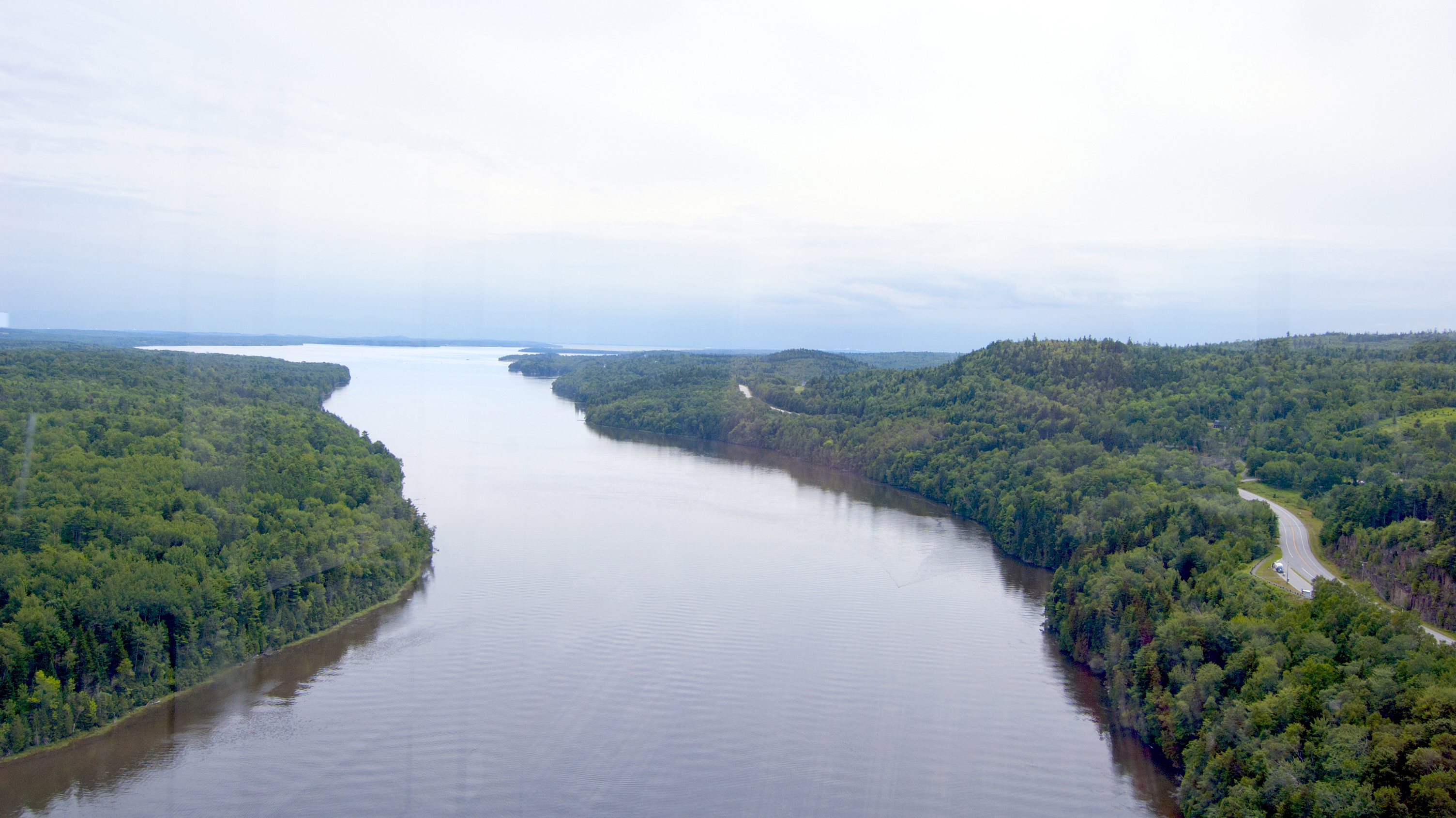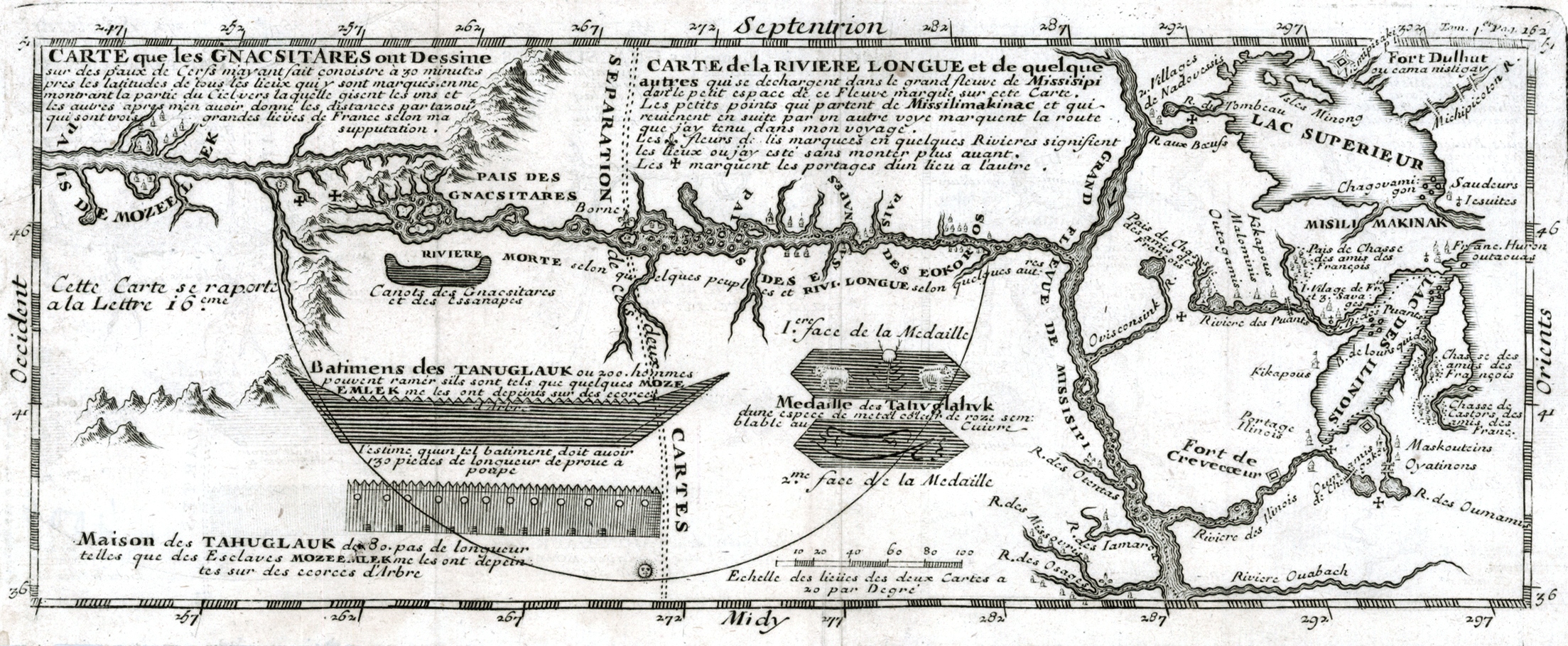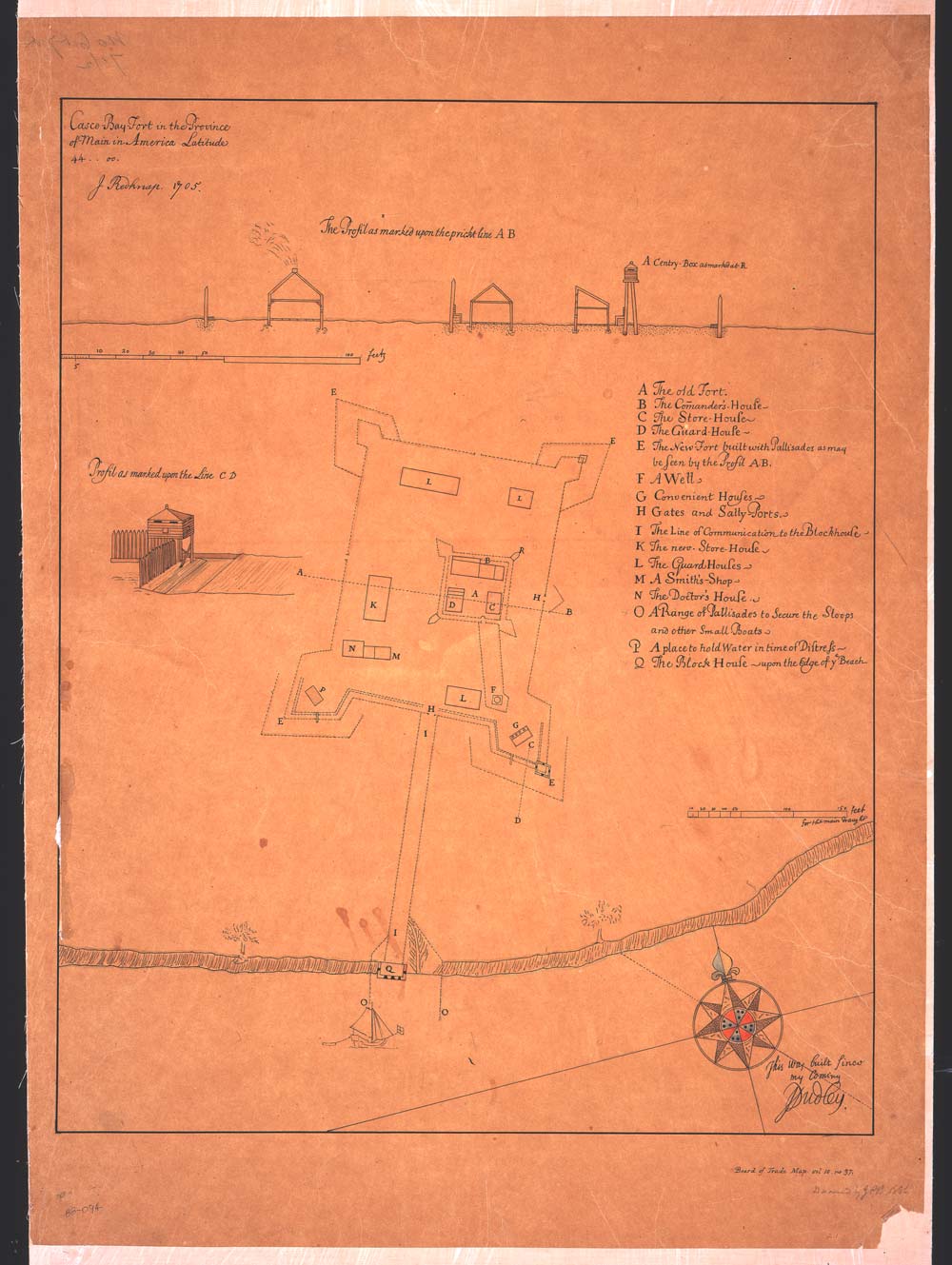|
Jean-Vincent D'Abbadie De Saint-Castin
Jean-Vincent d'Abbadie de Saint-Castin (1652–1707) was a French military officer serving in Acadia and an Abenaki chief. He is the father of two prominent sons who were also military leaders in Acadia: Bernard-Anselme and Joseph. He is the namesake of Castine, Maine. He died at Pau, France, in 1707. Early life Saint-Castin was born at Escout, Béarn, France, to Jean-Jacques d'Abbadie and Isabeau de Béarn-Bonasse, the youngest of three sons. Little is known of his early years other than he lost his mother in infancy and his father before his teens. He left for Canada at the age of thirteen as an ensign in the army, as was suitable for the youngest son of a noble. He was likely part of Alexandre de Prouville's campaign against the Iroqois in 1666 although his name does not appear in surviving records until 1670 when he was part of the repossession of Acadia by the French. In the Penobscot River area he gained his knowledge of the Penobscot and was eventually adopted into a lo ... [...More Info...] [...Related Items...] OR: [Wikipedia] [Google] [Baidu] |
Escout
Escout is a commune in the Pyrénées-Atlantiques department in south-western France. See also *Communes of the Pyrénées-Atlantiques department The following is a list of the 546 communes of the Pyrénées-Atlantiques department of France. The communes cooperate in the following intercommunalities (as of 2020):Communes of Pyrénées-Atlantiques {{PyrénéesAtlantiques-geo-stub ... [...More Info...] [...Related Items...] OR: [Wikipedia] [Google] [Baidu] |
Penobscot River
The Penobscot River ( Abenaki: ''Pαnawάhpskewtəkʷ'') is a U.S. Geological Survey. National Hydrography Dataset high-resolution flowline dataThe National Map, accessed June 22, 2011 river in the U.S. state of Maine. Including the river's West Branch and South Branch increases the Penobscot's length to , making it the second-longest river system in Maine and the longest entirely in the state. Its drainage basin contains . It arises from four branches in several lakes in north-central Maine, which flow generally east. After the uniting of the West Branch with the East Branch at Medway (), the Penobscot flows south, past the city of Bangor, where it becomes navigable. Also at Bangor is the tributary Kenduskeag Stream. It empties into the Atlantic Ocean in Penobscot Bay. It is home to the Penobscot people that live on Indian Island, and considered to be The People's lifeblood. History Norumbega Most historians have accepted the Penobscot region as Jean Allefonsce ... [...More Info...] [...Related Items...] OR: [Wikipedia] [Google] [Baidu] |
Philippe Mius D’Entremont
Philippe Mius d’Entremont, 1st Baron of Pobomcoup (1609–1701) was an early settler of Acadia, and progenitor of the Muise and d’Entremont families of Nova Scotia. Biography Philippe Mius d’Entremont was born in Normandy, France, and he was expelled out of France because of who his daughter married and was sent to Acadia with his family in 1651 as a lieutenant-major with Charles de Saint-Étienne de la Tour, who had been named Governor of Acadia by Louis XIII of France first in 1631, and again by Louis XIV in 1651. The governor in July 1653 awarded him one of the few fiefs to constitute territory in North America, the first in Acadia, and the second in all Canada, the Barony of Pobomcoup. Pobomcoup, meaning in Mi'kmaq "land from which the trees have been removed to fit it for cultivation", extended from Cap-Nègre ( Clyde River) to Cap-Fourchu ( Yarmouth). He promoted agriculture on his seigneury and brought to his estate several indentured workers and a few families from P ... [...More Info...] [...Related Items...] OR: [Wikipedia] [Google] [Baidu] |
Emmanuel Le Borgne
Emmanuel Le Borgne de Belle-Isle (1610 – 5 August 1675) was the governor of Acadia in 1657–67 and was the claimant to the estate of Charles de Menou d'Aulnay who had governed Acadia until his death. Le Borgne was a highly successful merchant in France and had financed d’Aulnay in his Acadian trade. When d’Aulnay died by drowning, Le Borgne laid formal claim to the estate. He then sent an expedition to Acadia the next year to attempt a monopoly of the trade and secure the money owed to him. His youngest son, Alexandre Le Borgne de Belle-Isle, acted as governor temporarily, ahead of his father's arrival to Acadia. His competition was Charles de Saint-Étienne de la Tour at Saint John (whose daughter, Marie, was, in 1668, wed to his son, Alexandre) and another former governor of Acadia, Nicolas Denys, at Cape Breton. In 1653, along with raiding Pentagouet (Castine, Maine), LaHave, Nova Scotia, and Nipisguit (Bathurst, New Brunswick Bathurst ( 2021 population; UA ... [...More Info...] [...Related Items...] OR: [Wikipedia] [Google] [Baidu] |
Alexandre Le Borgne De Belle-Isle
Alexandre le Borgne de Belle-Isle (c. 1640 – c. 1693), the son of Emmanuel Le Borgne, was a temporary governor of Acadia Acadia (french: link=no, Acadie) was a colony of New France in northeastern North America which included parts of what are now the Maritime provinces, the Gaspé Peninsula and Maine to the Kennebec River. During much of the 17th and early .... References * External links ''Genealogie Quebec'' Le Borgne, Alexandre {{Acadia-stub ... [...More Info...] [...Related Items...] OR: [Wikipedia] [Google] [Baidu] |
Castine Hoard
The Castine Hoard (also known as ''The Castine Deposit'') is the name given to a treasure trove of around 500–2,000 North American colonial coins that were found in Castine, Maine. The coins were from various countries, and were buried sometime in the late 1600s. In the early 1840s the coins were discovered on a farm owned by the Grindle family. Origin The coins were thought to have been a secret stash belonging to Baron Jean-Vincent d'Abbadie de Saint-Castin. Castin moved from France to the new world, becoming a battalion leader and later a baron following the death of his father. Jean eventually fell in love with the trading post of Pentagoet, and moved there once his army duties had been complete. While in Pentagoet he became more than friendly with the Indians, eventually becoming a local chief. Jean later married the daughter of another chief, and they had a daughter. In 1704, British forces led by Major Church stormed and captured the village of Pentagoet. Fearing the B ... [...More Info...] [...Related Items...] OR: [Wikipedia] [Google] [Baidu] |
John Alden (sailor)
Capt. John Alden Jr. (ca. 1626 or 1627 – homepages.rootsweb.com; accessed January 20, 2019.His gravestone, which used the and the Annunciation Style of enumerating years with dual dating, recorded his death as having occurred on March 14, 1701/2: "Here lyeth ye body of John Alden Senior aged 75 years deceased March ye 14 1701/2". See also |
Louis-Armand De Lom D'Arce De Lahontan, Baron De Lahontan
Louis Armand, Baron de Lahontan (9 June 1666 – prior to 1716) served in the French military in Canada where he traveled extensively in the Wisconsin and Minnesota region and the upper Mississippi Valley. Upon his return to Europe he wrote an enormously popular travelogue. In it he recounted his voyage up the "Long River," now thought to be the Missouri. He wrote at length and in very positive terms about Native American culture, portraying Indian people as free, rational, and generally admirable. Early life He was born into the aristocracy and inherited the title Baron Lahontan upon his father's death in 1674. De Lahontan joined the troupes de la marine and was sent to New France in 1683 at age 17 along with two other officers and three companies of troops.Lanctôt, Gustave. The Oakes Collection. Ottawa: J.O. Patenaude, 1940. 11. After arriving at Quebec in November and settling in Beaupré, he would lead his company in 1684 on an unsuccessful offense against the Iroquois fr ... [...More Info...] [...Related Items...] OR: [Wikipedia] [Google] [Baidu] |
Madokawando
Madockawando (born in Maine c. 1630; died 1698) was a sachem of the Penobscot, an adopted son of ''Assaminasqua,'' whom he succeeded. He led the Penobscot on the side of the French against the English during King William's War. Biography The Penobscot lands, lying east of Penobscot River, were a part of the French colony of Acadia. The English returned this to France in the 1667 Treaty of Breda, though the English claimed that the territory between the Penobscot and the St. Croix Rivers was included in the Duke of York's patent. The Native Americans in the region were brought under French influence by Jean-Vincent d'Abbadie de Saint-Castin, known as Castin in the ''New England Chronicles,'' who was a trader who did much to gain influence with the Abenaki, Penobscot, and other local tribes. He settled among them, and married a daughter of ''Madockawando,'' a Penobscot chief. When King Philip's confederacy entered into a state of war with the Plymouth Colony, the eastern Penobsco ... [...More Info...] [...Related Items...] OR: [Wikipedia] [Google] [Baidu] |
Falmouth, Maine
Falmouth is a town in Cumberland County, Maine, United States. The population was 12,444 at the 2020 census. It is part of the Portland–South Portland–Biddeford, Maine metropolitan statistical area. This northern suburb of Portland borders Casco Bay and offers one of the largest anchorages in Maine. The town is home to three private golf clubs and the Portland Yacht Club. History Native Americans Native Americans followed receding glaciers into Maine around 11,000 BCE. At the time of European contact in the sixteenth century, people speaking a western dialect of the Wabanaki language inhabited present-day Falmouth. Captain John Smith observed a semi-autonomous band known as the Aucocisco living in Casco Bay. English explorer Christopher Levett met with the Aucocisco Sagamore Skittery Gusset at his summer village at the Presumpscot Falls in 1623. A combination of warfare and disease decimated Native peoples in the years before English colonization, creat ... [...More Info...] [...Related Items...] OR: [Wikipedia] [Google] [Baidu] |
Benjamin Church (ranger)
Benjamin Church (c. 1639 – January 17, 1718) was New England military leader and captain of the first ranger force in America (1675).John Grenier. ''The First Way of War: American War Making on the Frontier.'' Cambridge University Press. 2005. p. 35 Church was commissioned by Josiah Winslow, the Governor of the Plymouth Colony, to form the first ranger company for King Philip's War. He later commanded the company to raid Acadia during King William's and Queen Anne's wars in the early 1700s, as French and English hostilities played out in North America. The two powers were competing for control in colonial territories. He was promoted to major and ended his service at the rank of colonel, as noted on his gravestone. Church designed his forces to emulate Indian practices of warfare. Toward this end, he worked to adopt Indian techniques of small, flexible forces that used the woods and ground for cover, rather than mounting frontal attacks in military formation. English ... [...More Info...] [...Related Items...] OR: [Wikipedia] [Google] [Baidu] |
King Philips War
King Philip's War (sometimes called the First Indian War, Metacom's War, Metacomet's War, Pometacomet's Rebellion, or Metacom's Rebellion) was an armed conflict in 1675–1676 between indigenous inhabitants of New England and New England colonists and their indigenous allies. The war is named for Metacom, the Wampanoag chief who adopted the name Philip because of the friendly relations between his father Massasoit and the ''Mayflower'' Pilgrims. The war continued in the most northern reaches of New England until the signing of the Treaty of Casco Bay on April 12, 1678. Massasoit had maintained a long-standing alliance with the colonists. Metacom (), his younger son, became tribal chief in 1662 after Massasoit's death. Metacom, however, forsook his father's alliance between the Wampanoags and the colonists after repeated violations by the colonists. The colonists insisted that the 1671 peace agreement should include the surrender of Native guns; then three Wampanoags were ... [...More Info...] [...Related Items...] OR: [Wikipedia] [Google] [Baidu] |





